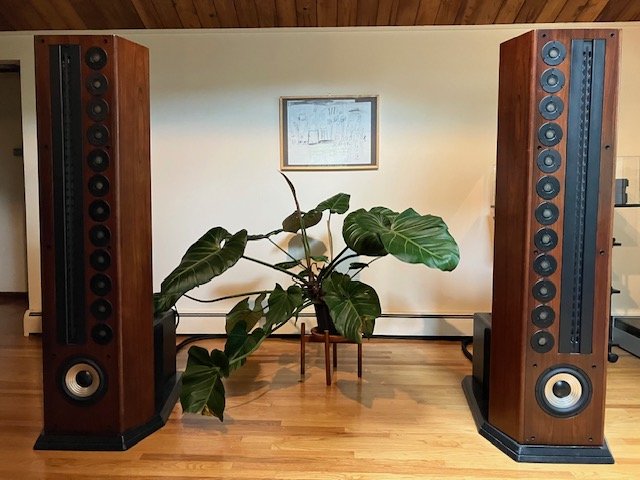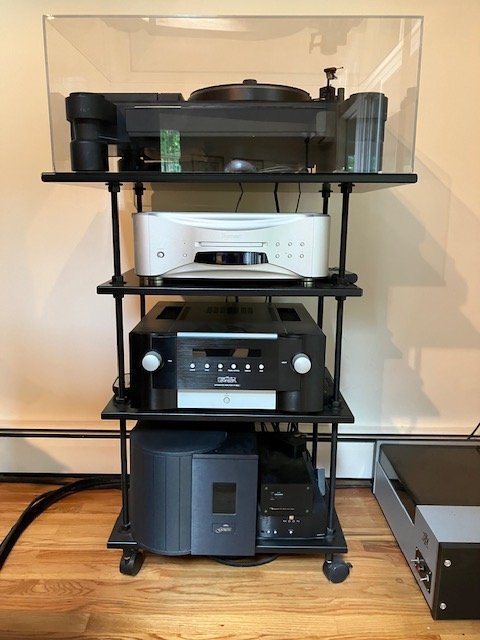Genesis owners are likely to be music lovers who will keep their speakers all their lives. Hence, while designing new products and models, we also focus on what can be used to maintain and upgrade 20, 30 year old models.
Two years ago, Stanley, the owner of a 25-year old pair of G350SE's, needed to change his 48-inch midranges because they were distorting on piano notes (and he's a big fan of classical music). His reaction after installation:
"The change in the midrange is actually transformative. The most distinctive change is in the soundstage, primarily depth but also width. The image is now virtually the concert-hall: on that score, nothing short of amazing."
A year later, he replaced the crossover and tweeters and reported:
"The change in sound is not slight or subtle. It’s obvious that the mids, the crossovers and the tweeters are matched units. They integrate perfectly and sound right together. I can confirm that my speculations about aging of the mids and the tweeters were right. As I wrote earlier— and we both knew this — the mids do age, with resulting occasional buzz. But they also distort slightly. When I replaced them, the sound became noticeably clearer, more transparent. With the tweeters, this was even more evident. Much of the harshness — it is now clear to me — was distortion. Interestingly, not particularly level dependent. The new tweeters are notably clearer, sweeter, and better integrated. In most source material, the sound is just magnificent. Source-dependent, of course: it’s easy to distinguish the quality of mastering. The greatest change is in imaging, which is often simply amazing."
Now, he's gone ahead to replace woofers and the servo-bass cables!!
"The 350se’s have now had a long workout, and I can report that they sound magnificent. The updates integrate perfectly, and justify amply the cost - and effort - to install them. A few detailed notes:
(1) On anything keyboard — notably piano and organ — they are truly a reference system.
(2) Same to be said on jazz, particularly small groups. On large bands, badly mastered recordings occasionally reveal some top edge raspiness: clearly the recording, rarely particularly objectionable.
(3) Classical chamber music — string quartets, piano trios, etc. — again absolutely reference quality. I can hear the walls of the recording studio.
(4) Big orchestral recordings: ruthlessly revealing, as I reported earlier. If well mastered, they are harmonically perfect. If really well mastered, you are sitting in the hall, sometimes up front, usually in mid orchestra. If badly mastered, the strings are edgy in crescendos. Not volume dependent: I have verified, over and over again, it’s on the recording. Even on some LP’s, notably early Phillips and DG.
I’m a very pleased listener!
Stanley"
Pics of Stanley's system:

Stanley's 350SEs with a huge Monstera plant in the center.

Nakamichi TX-1000/Graham/Koetsu
Esoteric Grandioso K-1X
Levinson 585.5 Integrated amplifier
Yes, he's had the old Servo Amplifier recapped!
Two years ago, Stanley, the owner of a 25-year old pair of G350SE's, needed to change his 48-inch midranges because they were distorting on piano notes (and he's a big fan of classical music). His reaction after installation:
"The change in the midrange is actually transformative. The most distinctive change is in the soundstage, primarily depth but also width. The image is now virtually the concert-hall: on that score, nothing short of amazing."
A year later, he replaced the crossover and tweeters and reported:
"The change in sound is not slight or subtle. It’s obvious that the mids, the crossovers and the tweeters are matched units. They integrate perfectly and sound right together. I can confirm that my speculations about aging of the mids and the tweeters were right. As I wrote earlier— and we both knew this — the mids do age, with resulting occasional buzz. But they also distort slightly. When I replaced them, the sound became noticeably clearer, more transparent. With the tweeters, this was even more evident. Much of the harshness — it is now clear to me — was distortion. Interestingly, not particularly level dependent. The new tweeters are notably clearer, sweeter, and better integrated. In most source material, the sound is just magnificent. Source-dependent, of course: it’s easy to distinguish the quality of mastering. The greatest change is in imaging, which is often simply amazing."
Now, he's gone ahead to replace woofers and the servo-bass cables!!
"The 350se’s have now had a long workout, and I can report that they sound magnificent. The updates integrate perfectly, and justify amply the cost - and effort - to install them. A few detailed notes:
(1) On anything keyboard — notably piano and organ — they are truly a reference system.
(2) Same to be said on jazz, particularly small groups. On large bands, badly mastered recordings occasionally reveal some top edge raspiness: clearly the recording, rarely particularly objectionable.
(3) Classical chamber music — string quartets, piano trios, etc. — again absolutely reference quality. I can hear the walls of the recording studio.
(4) Big orchestral recordings: ruthlessly revealing, as I reported earlier. If well mastered, they are harmonically perfect. If really well mastered, you are sitting in the hall, sometimes up front, usually in mid orchestra. If badly mastered, the strings are edgy in crescendos. Not volume dependent: I have verified, over and over again, it’s on the recording. Even on some LP’s, notably early Phillips and DG.
I’m a very pleased listener!
Stanley"
Pics of Stanley's system:

Stanley's 350SEs with a huge Monstera plant in the center.

Nakamichi TX-1000/Graham/Koetsu
Esoteric Grandioso K-1X
Levinson 585.5 Integrated amplifier
Yes, he's had the old Servo Amplifier recapped!

